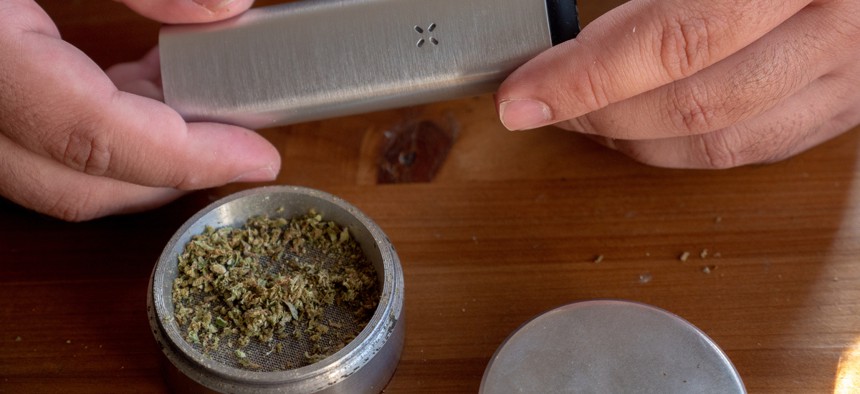Legal Marijuana in Oregon Hasn't Curbed Illegal Trafficking, Report Says

Researchers found that Oregon's annual pot production far exceeds local demand. Shutterstock
The new report found that pot grown in Oregon is flooding illegal markets in at least 37 other states.
Legalization of marijuana in Oregon has done little to curb illegal cultivation and distribution of the drug, as pot grown in Oregon is flooding illegal markets in multiple states, according to a new report.
The research, released this week by the Oregon-Idaho High Intensity Drug Trafficking Area, or HIDTA, found that the state’s annual marijuana yield far outpaces local demand, leading to collapsing prices, negative environmental impacts and trafficking across state lines.
HIDTA is a federal program administered by the White House Office of National Drug Control Policy, designed to provide resources to federal, state, local and tribal agencies to coordinate activities to address drug trafficking.
Researchers found that the state’s capacity to produce pot exceeds 2 million pounds each year, much more than the 186,100 to 372,600 pounds its residents consume on an annual basis. There are about 417,000 active users in Oregon—comprising roughly 10 percent of the state’s population—and about one state-sanctioned grow site for every 19 users, many of them in economically depressed counties.
“As a result of overproduction, impoverished counties that are heavily engaged in the cultivation of cannabis, such as Jackson, Josephine, and Lane, face a critical economic risk from collapsing cannabis prices,” says the report, titled An Initial Assessment of Cannabis Production, Distribution and Consumption in Oregon 2018. “A glut of cannabis stockpiles stemming from overproduction has caused a 50 percent annual price drop since 2016.”
Cannabis is a resource-intensive plant, researchers said, and cultivating it over the long term can result in negative environmental impacts, particularly on water supplies. An average mature plant consumes 22.7 liters of water per day, more than a vineyard grapevine, and 1 kilogram of finished flower requires 5.2 megawatt hours yearly (or twice the average annual energy consumption of a refrigerator).
That results in “the release of 4.5 metric tons of carbon dioxide (equal to the average yearly emissions of a passenger car),” the report says. “Due to historic use of and the exponential growth of cannabis cultivation, the Rogue River Basin is under acute hydrologic strain.”
Most of that marijuana goes unused. As of 2018, only 31 percent of the available inventory had been distributed, leaving 69 percent unconsumed within the recreational system.
Dispensary owners pushed back on that statistic, saying that much of the unused portion is comprised of parts of the plant—stems, loose leaves—that aren't incorporated into the final product.
"It's between a third, I would say, and about half the product that goes to waste that is the undesirable part," Miracle Greens owner Will Davis told the Associated Press.
Despite the abundance of legal marijuana, illegal growing and trafficking continues unabated, the report says. In 2016 alone, more than 26,500 plants with a total worth of $362 million were removed from public lands in Oregon, and from 2011 through 2016, illegal sites produced $2.1 billion worth of cannabis.
Over a two-and-a-half year period, from July 2015 to January 2018, 14,550 pounds of marijuana grown in Oregon worth more than $48 million was seized by law enforcement en route to 37 states. Pot was most frequently sent from Oregon to Minnesota, Florida, Wisconsin, Missouri, Virginia, Illinois, Arkansas, Iowa, Maryland and Texas, according to the report.
Law enforcement officers have also seized money coming into the state from distribution of cannabis elsewhere, the report says.
“Between July 2017 and March 2018, law enforcement seized nearly $1.7 million in proceeds coming into Portland International Airport from the illegal cannabis trade,” it says. “Police also seized another $861,000 in marijuana moving through the airport during that period.”
Cannabis products from Oregon are also sold online and frequently paid for using Bitcoin and other digital currencies, according to the report.
The report does not suggest solutions for the problems it identifies, noting that the research exists solely to “continuously examine the effects of cannabis production, distribution, and consumption in Oregon.” It’s the first comprehensive look at the state’s recreational marijuana market since voters legalized it in 2014.
A spokesman for the governor did not respond to requests for comment.
The report sheds a light on the link between marijuana legalization and "interstate criminal activity," U.S. Attorney Billy J. Williams said in a statement.
"Overproduction is rampant and the illegal transport of product out of state—a violation of both state and federal law—continues unchecked," he said. "My ask continues to be for transparency, responsible regulation, adequate funding, and a willingness to work together. It’s time for the state to wake up, slow down, and address these issues in a responsible and thoughtful manner.”
Kate Elizabeth Queram is a Staff Correspondent for Government Executive’s Route Fifty and is based in Washington, D.C.
NEXT STORY: Can Philanthropy Save a City?





